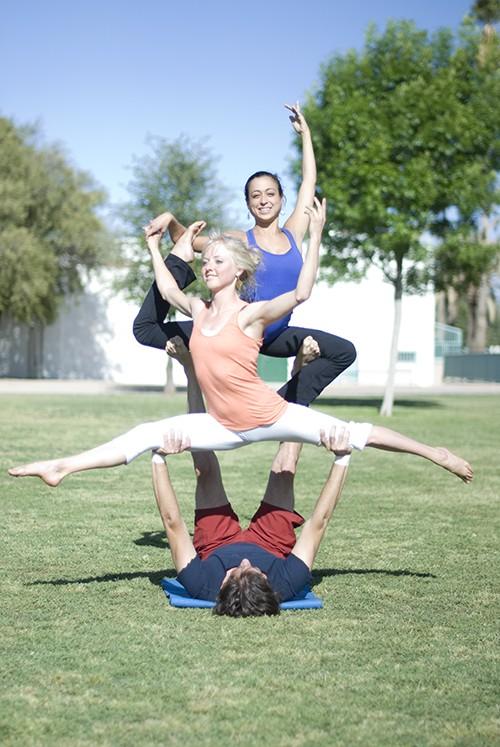On a breezy, sunny afternoon in Himmel Park, Aaron Farber, Emily Wilkinson and Kyra Weinberger are doing what they call “”playing.”” Farber, who is a “”base,”” lies on his back on a yoga mat, his legs extended, feet soles-up in the air. The two women take turns balancing on his feet, using every possible body part. They glide gracefully between positions, first extending their whole bodies flat in the air, like swimmers, then moving effortlessly into splits or beautifully arching backbends. Farber supports them, adjusting his feet or extending his arms and clasping their hands to aid their transitions. The result looks like a lovely cross between ballet, gymnastics and yoga. The pairs’ bodies seem completely in sync, the trust between partners complete.
The three are members of Flight School Acrobatics, a troupe of acrobats and acro-yoga practitioners who perform in Tucson and throughout the state. “”Next weekend, we’re going to Sedona for a prom,”” laughed Farber, an aerospace engineering doctoral candidate at the UA.
The troupe has 10 to 12 members, depending on “”who’s in town,”” according to Farber. Their rehearsals depend on the troupe’s performance schedule, but most troupe members work with other members of the large Tucson acro-yoga community up to three times a week.
According to Wilkinson, acro-yoga in the United States is a fusion of Thai massage, acrobatics and yoga. Thai massage involves “”using your own body to manipulate another person’s body to put them in a position where you can give them massage,”” Wilkinson said. Farber added that elements of acro-yoga can be “”geared toward therapeutics,”” but that the practice also incorporates “”partner work, communication and trust.””
“”Much more of it is geared toward having a good time,”” Farber said. “”When we practice, we call it ‘playing.’ There’s usually a lot of laughing.””
Though some Tucson yoga studios offer acro-yoga workshops or “”jams,”” Flight School members can most often be seen practicing outdoors, in parks or, occasionally, on the UA Mall.
The troupe found each other organically, said Wilkinson, a third-year UA medical student.
“”I actually went to the first acro-yoga class that was offered in Tucson, and immediately fell in love with it,”” she said. “”As the community grew in Tucson, it became very apparent that there was a smaller group that was really dedicated to acro.””
That small group began meeting outside of yoga classes, and eventually began discussing the possibility of forming a performance-oriented acrobatics group.
“”A number of those people that were drawn to it are also artists,”” Wilkinson said. “”If a performance artist is drawn to a new craft, I think they want to automatically put it on stage.””
Wilkinson and Farber agree that, while they would not have considered themselves performance artists before finding acro-yoga, Flight School Acrobatics has helped them to define themselves as artists.
On the other hand, Weinberger, a yoga instructor and fellow Flight School member, has explored many performance outlets.
“”I was a professional ballet dancer and an opera singer,”” she said. But she no longer performs in either of those capacities.
“”Acro is exactly what I need to still keep my hamminess on stage,”” she said. “”Acro does something for me that no other type of performance has done for me. It makes me happier than almost anything else.””
All three have been struck by how open the Tucson community is to performance art.
“”The yoga community, for one, is huge,”” Weinberger gushed. “”And I don’t think, even living in larger cities, I’ve ever seen such a pull for the carnival arts.””
Farber thinks the Tucson weather and outdoorsy spirit may have something to do with the proliferation of performance artists. “”A lot more people are interested in being outside and being active,”” he said. “”I’ve never been anywhere where I’ve met so many people who were into performance art. For a city this size, it’s really impressive.””
So why Tucson? Weinberger speculates that Tucson’s relative dearth of professional performance organizations has caused artists to fill that gap in more creative ways.
“”There are so many people doing their own thing, and it works,”” she said. “”The lack of that organization brings this amazing un-organization.
“”And there’s so much talent,”” she added.
All three encourage anyone interested in acro-yoga to try it.
“”It’s really something you can just do,”” Farber said. “”You don’t have to have some background in gymnastics to just hang.””









